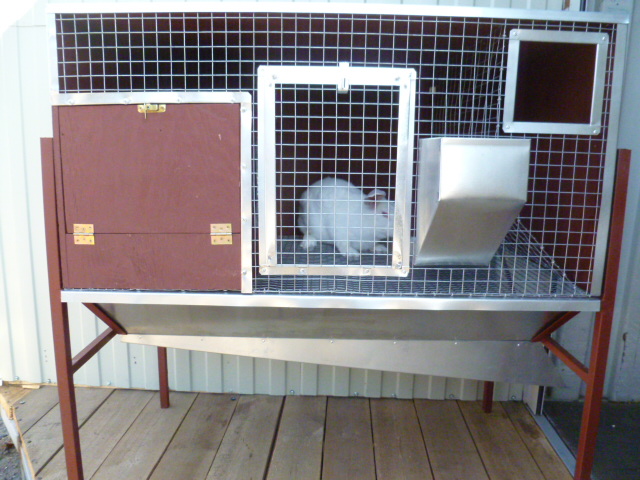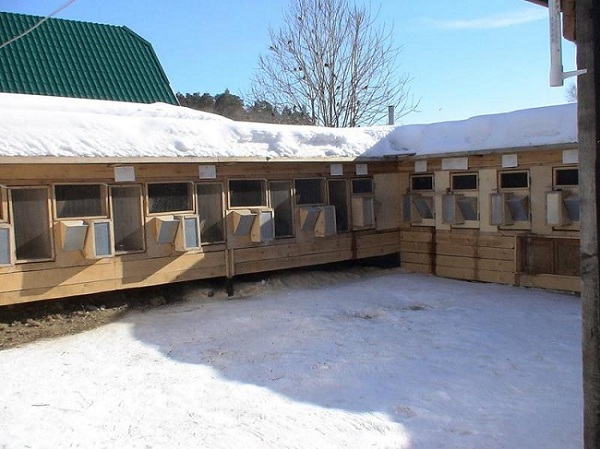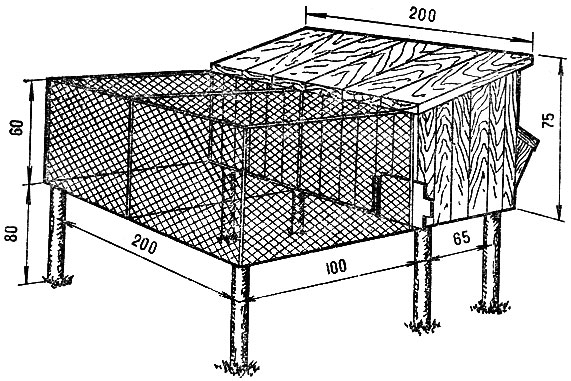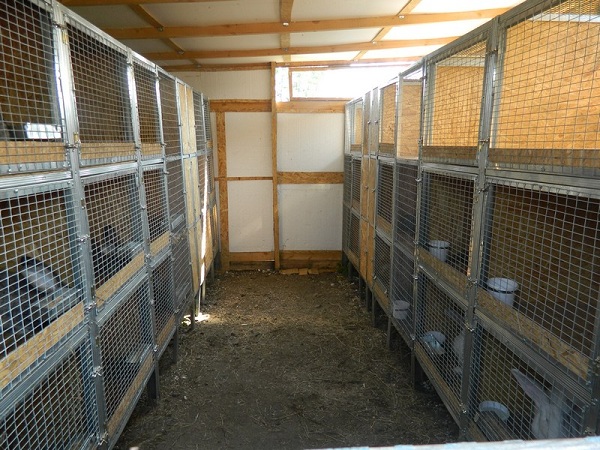For the normal development of rabbits in an artificial environment, adequate conditions should be created. And it’s not just about food, but also about accommodation. In the vast majority of cases, rabbits are placed in cages. Their location plays a significant role in the development of animals. A metal cage is installed where there are trees to protect them from the cold in winter.
Steel cages are not in short supply and can be easily purchased in stores. However, it will be much more interesting and somewhat cheaper to make the product yourself. To do this, use galvanized mesh for cages (the same kind of cages for dogs are made from) and other materials. After all, you can buy any model from the manufacturer, the only question is how much it will cost.
There is another alternative, more economical - to buy a previously used cage. With this approach, you need to be prepared for the fact that some repairs may be required. In addition, it is not a fact that the proper level of comfort for rabbits will be provided.Therefore, next we will consider how you can make a cage with your own hands, and what is needed for this.1 Features of the design
First, you need to determine what format the metal mesh for the rabbit is needed (welded non-galvanized, chain-link, plaster). In this case, you need to take into account the place where the product will be located: at home or on the street.
If a cage is needed not just for keeping a rabbit, but for breeding them, then it is worth considering cages for pregnant females, males and rabbits. Moreover, they can be with or without walking.
Let's consider what design flaws may arise when building with your own hands.
You can make a floor for a rabbit out of wood if Daily cleaning is expected however, this is not a very convenient approach, especially in winter when the manure freezes in outdoor conditions.
A do-it-yourself mesh floor with a 20x20 mm mesh is an excellent solution, since it provides natural ventilation, while manure does not accumulate as much as with a solid floor. When choosing this option for making a floor, you need to be careful, given the size of the cells, 20x20 mm will be an excellent option.
If you use large ones (for example, non-galvanized chain-link, or large-mesh plaster), the rabbit’s back paw may be compressed, which will certainly lead to injury. In addition, in winter, exposed parts of the animal’s body can simply freeze to the metal elements of the mesh.
![]()
A front welded mesh with a small door is not a very convenient solution, since getting rabbits out of such a structure is problematic.
If you do not make stands for the cage, it will be extremely inconvenient to carry it.
It is better not to make a nesting section, since through negligence a female rabbit can crush her babies on these boxes.
Often, as a result of saving mesh, other materials and space, the cells turn out to be cramped. This can cause obesity and the development of diseases.
1.1 Construction of a cage for rabbits
Let's look at how to build a cage with your own hands and what you need to make it. First of all, you need to choose quality material.
- for manufacturing it is worth buying boards or plywood;
- You can make a frame and supports from wooden blocks;
- mesh (welded plaster, non-galvanized chain-link) must have small cells - up to 20×20 mm;
- finishing slats should be about 3 cm wide.
It is necessary to ensure that the wooden material is smooth and even, without protrusions.
The cell size is determined individually: depending on the weight and breed of the rabbit. Minimum options:
- length – from 150 cm;
- height – from 50 cm;
- width – from 70 cm.
If the rabbits will not be placed outdoors, you can make houses for them. They are used to living in minks (in natural conditions), so they will be more comfortable in them.
For the queen cell, you can use a box 20 cm high and 35 cm wide and long. The floor is solid flooring.

If you make a nesting compartment, then it needs to be fenced with a partition with a hole with a diameter of 20 cm, located at a height of 10 cm from the floor. You can also buy a piece of tin to cover the partition to prevent animals from gnawing on it.
The cages can be installed on bars measuring about 80 cm, if it is intended to be used outdoors. This will protect the rabbits from rodents and pets. At the same time, it will be more convenient to maintain at a height.
1.2 Cell parts
Let's highlight the main elements of the cage that you need to make yourself:
- walls;
- roof.
For walls, non-galvanized metal mesh, chain-link or welded, as well as wood and plywood can be used. The floor can be made of fine mesh 20x20 mm or slats. If you make a solid wooden floor, then you need to lay slatted flooring on top of it. The slats should be 15 cm apart from each other.
The roof will protect the rabbits from the weather, as well as the likely exposure of other animals. If the cage will be placed outside, the roof should be covered with tiles.

Feeders and drinking bowls should be made retractable, hinged and placed outside, so that it is more difficult for rabbits to pollute them.
2 Diagram of a medium-sized cell
You can make a frame of this size with your own hands:
- height – 70 cm;
- front part – 55 cm;
- rear – 35 cm.
After the frame is made, it is sheathed. Board or plywood is used. It is better to make the roof folding.

At the location of the nest, the door must be made solid. The rabbit should enter the walking compartment through the latch located at the back.
2.1 Cage diagram for home keeping
The back wall is made in the following sizes:
- height – 55 cm;
- length – 100 cm.
Side walls:
- width – 70 cm;
- height – 70 cm.
The cage is installed on slats at a height of about 15 cm from the floor. The top rail must be made lower than the top edge, so that the roof rests on it. A tray must be installed under the mesh.
2.2 All-wire version
Their peculiarity is that they can be placed in any type of room. They take up little space and allow for convenient cleaning and disinfection.

It is recommended to raise rabbits for sale in all-wire cages, as they simplify the procedure for caring for the animals. This option can be made with your own hands or bought. A propane torch and brush are required for cleaning.The flame destroys harmful microorganisms, which are very dangerous for any rabbit. At the same time, you can conveniently get to the fluff, which accumulates over time and clogs the cage.
The size of the cells of the chain-link mesh used, or if a welded non-galvanized mesh is used for making the top and walls, should be 2.5 x 5 cm, for the floor - 3.5 x 2.5 cm. This will make cleaning somewhat easier, and it will be convenient for rabbits to live in such conditions .
Here are a few more recommendations that will help you build structures with your own hands. For males, the house can be made smaller, than a normal cell. But you need to make sure that there is enough space to move it.
Experts advise leaving baby rabbits with their mother first so that they reach slaughter weight faster. However, there are situations when rabbits need to be weaned from their mother, but weight has not been achieved. Therefore, you need to use an additional house in which rabbits can be raised to gain weight.
For 3-4 rabbits you can build one large cage. It should be noted that there is no need to despair if you cannot build the structure yourself. After all, you can buy a ready-made solution at any time that will help you realize your plans.
